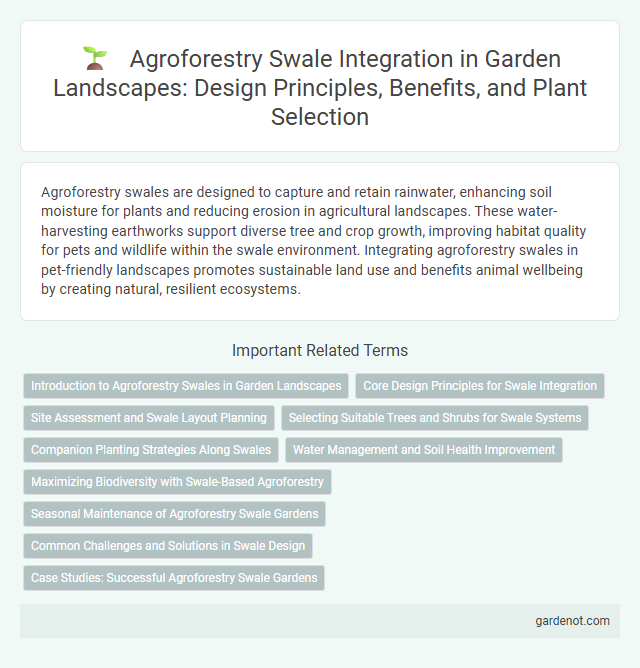Agroforestry swales are designed to capture and retain rainwater, enhancing soil moisture for plants and reducing erosion in agricultural landscapes. These water-harvesting earthworks support diverse tree and crop growth, improving habitat quality for pets and wildlife within the swale environment. Integrating agroforestry swales in pet-friendly landscapes promotes sustainable land use and benefits animal wellbeing by creating natural, resilient ecosystems.
Introduction to Agroforestry Swales in Garden Landscapes
Agroforestry swales are landscape features designed to capture and infiltrate rainwater, improving soil moisture and supporting diverse plant growth in garden settings. These earthworks integrate trees, shrubs, and groundcover in a structured layout to enhance water retention, reduce erosion, and promote sustainable microclimates. Incorporating agroforestry swales in garden landscapes optimizes water management while fostering biodiversity and soil health.
Core Design Principles for Swale Integration
Agroforestry swale design centers on contour alignment to maximize water retention and minimize erosion, enhancing soil fertility and plant growth. Incorporating perennial trees and shrubs along swale banks promotes biodiversity, optimizes nutrient cycling, and stabilizes microclimates. Soil structure preservation and multi-layered vegetation integration maintain watershed health and improve agroecosystem resilience.
Site Assessment and Swale Layout Planning
Agroforestry swale site assessment involves analyzing soil type, slope gradient, and hydrology to ensure optimal water infiltration and erosion control. Swale layout planning requires precise contour mapping to position channels along keylines, maximizing water retention and supporting tree root zones. Effective swale design integrates native vegetation patterns and existing land use to enhance biodiversity and agricultural productivity.
Selecting Suitable Trees and Shrubs for Swale Systems
Selecting suitable trees and shrubs for agroforestry swale systems involves prioritizing species with deep root systems that enhance soil stabilization and water infiltration. Native drought-tolerant species such as Acacia, Casuarina, and nitrogen-fixing legumes support nutrient cycling and improve soil fertility while providing shade and habitat diversity. Integrating a mix of fruit trees like mango or guava with shrubs such as pigeon pea or moringa maximizes both ecological benefits and sustainable yield.
Companion Planting Strategies Along Swales
Agroforestry swales integrate companion planting strategies to enhance soil fertility, moisture retention, and biodiversity along contour lines. Planting nitrogen-fixing species like legumes adjacent to fruit trees and deep-rooted perennials helps improve nutrient cycling and stabilize soil structure. Diverse plant combinations along swales also reduce pest pressures and promote ecosystem resilience by supporting beneficial insects and microorganisms.
Water Management and Soil Health Improvement
Agroforestry swales efficiently capture and infiltrate rainwater, reducing surface runoff and enhancing groundwater recharge. This water management technique boosts soil moisture retention, promoting healthier root systems and reducing erosion risks. Improved soil structure and increased organic matter from agroforestry swales support nutrient cycling and foster biodiversity for sustainable land productivity.
Maximizing Biodiversity with Swale-Based Agroforestry
Swale-based agroforestry integrates diverse plant species along contour ditches to enhance water retention and soil fertility, creating microhabitats that support a wide range of flora and fauna. This method promotes biodiversity by providing varied niches for pollinators, birds, and beneficial insects, while improving ecosystem services such as carbon sequestration and nutrient cycling. Implementing layered plantings in swales optimizes space and resource use, fostering resilient agroecosystems that sustain productivity and ecological balance.
Seasonal Maintenance of Agroforestry Swale Gardens
Seasonal maintenance of agroforestry swale gardens involves regular inspection and management to ensure optimal water retention and soil health. Removing accumulated debris and pruning trees and shrubs help prevent blockages and promote healthy growth during wet and dry seasons. Monitoring soil moisture and nutrient levels allows timely interventions, enhancing the swale's effectiveness in supporting diverse plant species.
Common Challenges and Solutions in Swale Design
Agroforestry swale design often faces challenges such as soil erosion, waterlogging, and improper slope gradient, which can reduce water infiltration and root health. Solutions include contouring swales closely along natural land contours, incorporating mulch and organic matter to enhance soil structure, and selecting drought-resistant plant species to improve resilience. Integrating native trees and shrubs with diverse root systems promotes enhanced water retention and nutrient cycling within the swale ecosystem.
Case Studies: Successful Agroforestry Swale Gardens
Agroforestry swale gardens demonstrate remarkable water retention and soil fertility improvements, as evidenced by case studies from the Sahel region and parts of India. These projects report up to 60% increased crop yields and enhanced biodiversity due to optimized runoff capture and nutrient cycling within contour-aligned swales. Research from permaculture farms in Australia highlights significant reductions in erosion and increased carbon sequestration, reinforcing agroforestry swales as sustainable land management solutions.
Agroforestry swale Infographic

 gardenot.com
gardenot.com